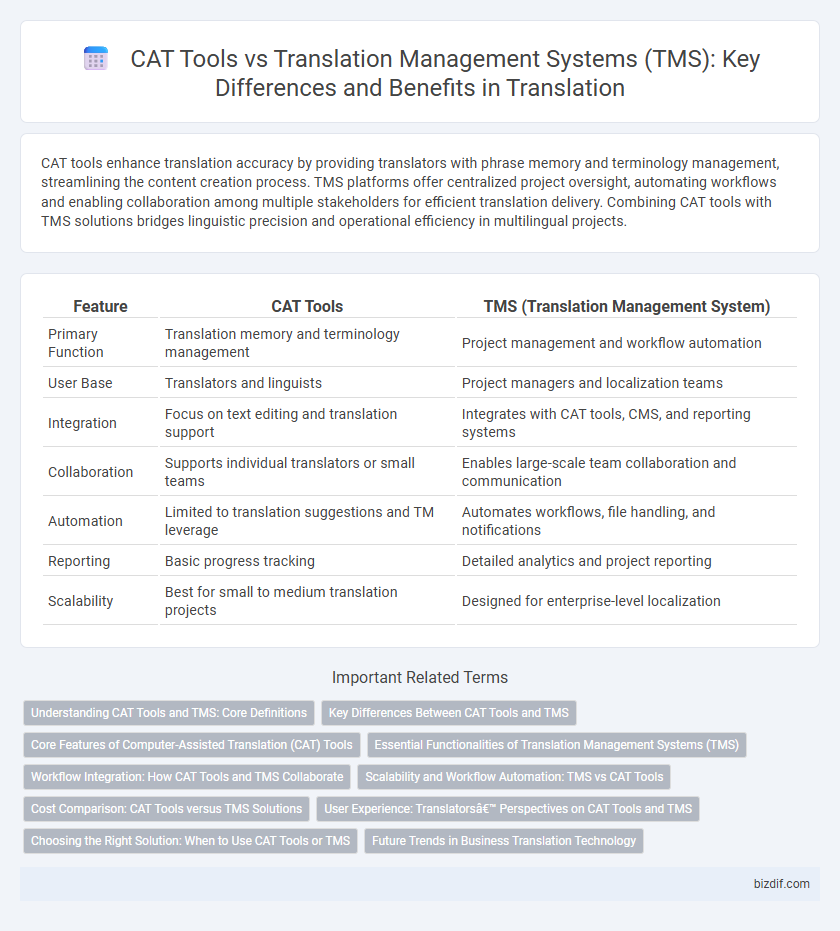CAT tools enhance translation accuracy by providing translators with phrase memory and terminology management, streamlining the content creation process. TMS platforms offer centralized project oversight, automating workflows and enabling collaboration among multiple stakeholders for efficient translation delivery. Combining CAT tools with TMS solutions bridges linguistic precision and operational efficiency in multilingual projects.
Table of Comparison
| Feature | CAT Tools | TMS (Translation Management System) |
|---|---|---|
| Primary Function | Translation memory and terminology management | Project management and workflow automation |
| User Base | Translators and linguists | Project managers and localization teams |
| Integration | Focus on text editing and translation support | Integrates with CAT tools, CMS, and reporting systems |
| Collaboration | Supports individual translators or small teams | Enables large-scale team collaboration and communication |
| Automation | Limited to translation suggestions and TM leverage | Automates workflows, file handling, and notifications |
| Reporting | Basic progress tracking | Detailed analytics and project reporting |
| Scalability | Best for small to medium translation projects | Designed for enterprise-level localization |
Understanding CAT Tools and TMS: Core Definitions
CAT tools, or Computer-Assisted Translation tools, are software applications designed to aid translators by providing features like translation memory, terminology management, and segmentation, enhancing efficiency and consistency. Translation Management Systems (TMS) are platforms that facilitate the entire translation workflow, including project management, collaboration, and automation of processes across multiple languages and teams. Understanding the core definitions clarifies that CAT tools focus on individual translation tasks, while TMS oversee and streamline the broader translation lifecycle.
Key Differences Between CAT Tools and TMS
CAT tools primarily enhance individual translator productivity by providing features like translation memory, terminology management, and real-time text segmentation, whereas TMS platforms streamline the entire localization workflow, integrating project management, collaboration, and automation for multiple stakeholders. CAT tools focus on linguistic accuracy and reuse of translation assets, while TMS emphasizes process optimization, resource allocation, and tracking across complex translation projects. The key difference lies in CAT tools serving translators directly, and TMS facilitating coordination and efficiency on a broader operational scale.
Core Features of Computer-Assisted Translation (CAT) Tools
Computer-Assisted Translation (CAT) tools primarily offer core features such as translation memory, terminology management, and automated quality assurance to enhance translation efficiency and consistency. These tools enable translators to reuse previously translated content, maintain uniform terminology across projects, and detect errors like inconsistencies or missing tags. Unlike Translation Management Systems (TMS), which focus on workflow automation and project coordination, CAT tools concentrate on improving the translation process at the linguistic level.
Essential Functionalities of Translation Management Systems (TMS)
Translation Management Systems (TMS) centralize project workflows by automating task assignments, progress tracking, and deadline management, enhancing efficiency across multilingual content production. Essential TMS functionalities include integration with CAT tools for seamless translation memory and terminology management, real-time collaboration among translators, editors, and project managers, and comprehensive reporting for quality assurance and cost control. These systems support scalability and consistency in large-scale translation projects by managing asset versioning and facilitating vendor management within a unified platform.
Workflow Integration: How CAT Tools and TMS Collaborate
CAT tools enhance translation productivity by offering advanced linguistic features such as translation memory, terminology management, and real-time editing. TMS platforms facilitate seamless workflow integration by automating project assignment, status tracking, and file exchange between translators and stakeholders. Their collaboration streamlines project management, ensuring consistent terminology and faster delivery in multilingual environments.
Scalability and Workflow Automation: TMS vs CAT Tools
Translation Management Systems (TMS) offer superior scalability and workflow automation compared to CAT tools by integrating end-to-end processes, from project initiation to delivery, in a centralized platform. TMS supports multiple users, languages, and project phases simultaneously, optimizing resource allocation and enabling seamless collaboration across large teams. In contrast, CAT tools primarily enhance individual translation productivity without extensive automation or comprehensive process management functionalities required for large-scale operations.
Cost Comparison: CAT Tools versus TMS Solutions
CAT tools generally offer a lower initial investment compared to TMS solutions, making them more cost-effective for freelance translators and small businesses. TMS platforms often involve higher upfront fees and subscription costs but provide comprehensive project management capabilities that streamline workflows for larger teams. The total cost of ownership for TMS can be justified by increased efficiency and integration features, while CAT tools emphasize affordability and immediate translation productivity.
User Experience: Translators’ Perspectives on CAT Tools and TMS
Translators often find CAT tools more intuitive for direct text manipulation and real-time editing due to their focused design on linguistic tasks. TMS platforms provide comprehensive project oversight but can overwhelm users with complex workflows, impacting translator efficiency and satisfaction. Many professionals prefer a seamless integration of CAT tools within TMS to optimize user experience and maintain translation quality.
Choosing the Right Solution: When to Use CAT Tools or TMS
CAT tools excel in enhancing individual translator productivity through features like translation memory, terminology management, and real-time editing. TMS platforms offer broader project management capabilities, including workflow automation, resource allocation, and multi-vendor coordination, making them ideal for large-scale, collaborative translation projects. Selecting the right solution depends on project scope: use CAT tools for focused, high-quality translation tasks and TMS for managing complex workflows and multiple stakeholders efficiently.
Future Trends in Business Translation Technology
Future trends in business translation technology emphasize seamless integration between CAT tools and TMS platforms to enhance workflow automation and consistency in multilingual content delivery. Artificial intelligence and machine learning advancements are driving improvements in translation memory accuracy, real-time collaboration, and predictive analytics for project management efficiency. Increased adoption of cloud-based solutions supports scalable, secure, and accessible translation ecosystems tailored to global business needs.
CAT Tools vs TMS (Translation Management System) Infographic

 bizdif.com
bizdif.com